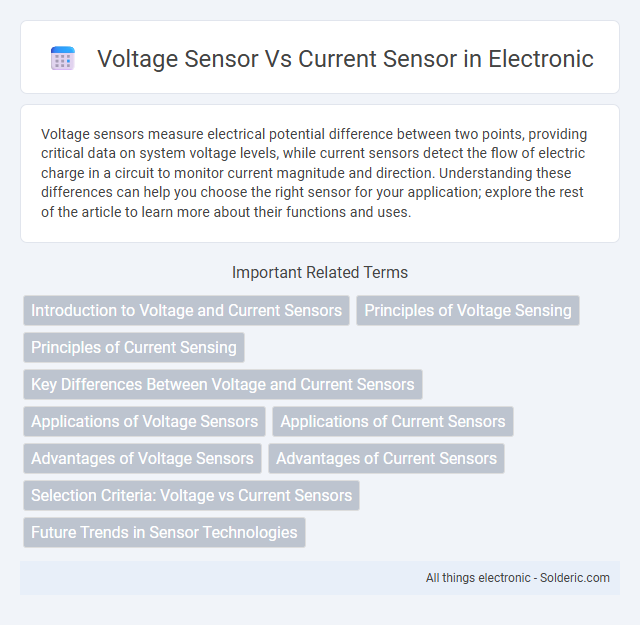Voltage sensors measure electrical potential difference between two points, providing critical data on system voltage levels, while current sensors detect the flow of electric charge in a circuit to monitor current magnitude and direction. Understanding these differences can help you choose the right sensor for your application; explore the rest of the article to learn more about their functions and uses.
Comparison Table
| Feature | Voltage Sensor | Current Sensor |
|---|---|---|
| Purpose | Measures electrical potential difference (voltage) | Measures electrical current flow |
| Output Type | Analog or digital voltage signal | Analog voltage signal or digital output proportional to current |
| Common Types | Resistive voltage divider, Hall effect, capacitive sensors | Shunt resistor, Hall effect, Rogowski coil |
| Typical Applications | Power monitoring, battery management, voltage regulation | Overcurrent protection, power measurement, motor control |
| Measurement Range | Low to high voltage (mV to kV) | Microamperes to kiloamperes |
| Sensitivity | High sensitivity to voltage variation | Depends on sensor type; Hall effect offers isolation |
| Isolation | Typically requires isolation for high voltage | Many provide galvanic isolation (Hall effect, Rogowski) |
| Installation | Connected across load or supply terminals | Placed in series with load current path |
| Accuracy | High accuracy for voltage measurement | Accuracy varies; shunt resistors provide precise measurement |
Introduction to Voltage and Current Sensors
Voltage sensors detect the electrical potential difference between two points in a circuit, providing crucial data for monitoring and control. Current sensors measure the flow of electric current through a conductor, essential for overload protection and energy management. Your choice between voltage and current sensors depends on whether you need to measure potential or actual current flow for accurate system diagnostics.
Principles of Voltage Sensing
Voltage sensors operate by detecting the electric potential difference between two points in a circuit, utilizing resistive voltage dividers, capacitive or inductive coupling methods to measure voltage levels accurately. These sensors convert the voltage into a measurable analog or digital signal without significantly altering the circuit's operation. Their precision relies on high input impedance and isolation techniques to ensure accurate readings and protect the measurement system from high voltages.
Principles of Current Sensing
Current sensing operates on Faraday's law of electromagnetic induction, measuring the magnetic field generated by current flow in a conductor, or using a shunt resistor to detect voltage drop proportional to current. Common types include Hall-effect sensors, which provide non-contact measurement, and shunt-based sensors, valued for their accuracy in low-voltage applications. Your choice between voltage and current sensors depends on the specific parameters you need to monitor in an electrical circuit for optimal performance and safety.
Key Differences Between Voltage and Current Sensors
Voltage sensors measure the electrical potential difference between two points in a circuit, typically expressed in volts, while current sensors detect the flow of electric charge through a conductor, measured in amperes. Voltage sensors often utilize methods such as resistive dividers, capacitive coupling, or Hall effect techniques, whereas current sensors commonly employ shunt resistors, Hall effect sensors, or current transformers. The primary distinction lies in their measurement targets--voltage sensors monitor potential difference without directly influencing circuit current, while current sensors gauge the magnitude and direction of current flow, crucial for load monitoring and protection systems.
Applications of Voltage Sensors
Voltage sensors are widely used in applications such as power monitoring, electrical safety systems, and voltage regulation in industrial automation. They enable real-time voltage measurement in renewable energy systems, battery management, and smart grid technologies. Accurate voltage sensing is critical for preventing equipment damage and ensuring efficient energy usage in both residential and commercial electrical installations.
Applications of Current Sensors
Current sensors are widely used in applications such as motor control, energy management systems, and overload protection in industrial equipment. They enable real-time monitoring of electrical currents to detect faults, improve efficiency, and ensure safety in power distribution networks. These sensors are critical components in electric vehicles, renewable energy systems, and smart grid technologies for accurate current measurement and control.
Advantages of Voltage Sensors
Voltage sensors offer precise measurement of electrical potential difference, enabling accurate monitoring and control of voltage levels in power systems and electronic devices. They provide high sensitivity and rapid response times, essential for detecting voltage fluctuations and ensuring system stability. Their non-invasive design often allows for safer installation and reduced risk of circuit interference compared to current sensors.
Advantages of Current Sensors
Current sensors offer precise measurement of electric current flow, essential for monitoring and protecting electrical circuits in real-time. They provide enhanced safety by detecting overloads and short circuits quickly, reducing the risk of equipment damage and fire hazards. Their compatibility with various system types, including AC, DC, and pulsed currents, makes them versatile for industrial automation and energy management applications.
Selection Criteria: Voltage vs Current Sensors
When selecting sensors, voltage sensors accurately measure electrical potential difference and are ideal for monitoring power supply levels, while current sensors detect the flow of electric charge and are essential for assessing load conditions or detecting overloads. Factors influencing your choice include the required measurement range, precision, response time, and application environment, such as whether you need to measure AC or DC signals. Understanding these criteria ensures optimal sensor performance and reliable data acquisition for your electrical monitoring system.
Future Trends in Sensor Technologies
Emerging trends in voltage and current sensors emphasize the integration of smart technologies and IoT connectivity to enable real-time monitoring and predictive maintenance in energy systems. Advanced materials like graphene and nanostructures enhance sensor sensitivity and miniaturization, supporting high-frequency and high-precision measurements in electric vehicles and renewable energy grids. The shift toward non-contact and wireless sensing solutions improves safety and reduces installation complexity, driving the adoption of these sensors in smart grids and industrial automation.
Voltage sensor vs current sensor Infographic

 solderic.com
solderic.com